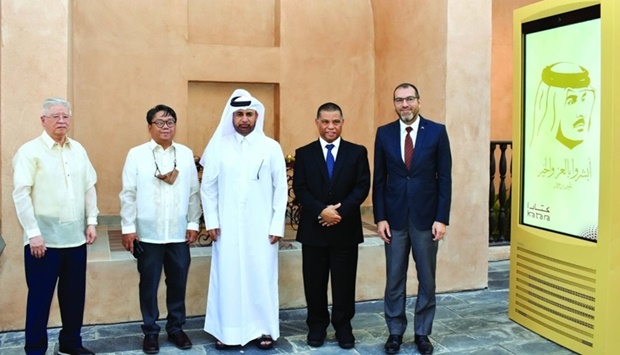* 'Philippines Corner' inaugurated at Cultural Village
A unique artwork titled ‘Kulintang’ by Frederick Epistola, one of the Philippines’ renowned visual artists, was unveiled as a permanent installation in the new 'Philippines Corner' at Katara – the Cultural Village Sunday.
The event was graced by Philippine ambassador Alan L Timbayan and Katara general manager HE Prof Khalid bin Ibrahim al-Sulaiti, along with Indonesia's ambassador Ridwan Hassan, Costa Rica deputy head of mission Jairo Lopez Bolanos, other diplomats representing different embassies, art enthusiasts and guests.
HE Prof Khalid bin Ibrahim al-Sulaiti, Alan Timbayan and Frederick Epistola led the unveiling of the new permanent art installation at Katara Sunday.
The 'Philippines Corner' was inaugurated by HE Prof al-Sulaiti in the presence of the other dignitaries. The opening comes within the framework of Katara's artistic project, which aims to attract artists from all over the world and enable them to display their works in different corners of the Cultural Village, helping people learn about the heritage of different countries.
“I am deeply honoured and grateful for this opportunity to use my art as an expression of my heritage, and as a vehicle to translate the Filipino identity across space and time," Epistola said. “The kulintang is tied to the musical culture of the Maguindanaon tribe in the Southern Philippines. It has become an instrument representative of Philippine gong music, and beyond that, an instrument to celebrate a living tradition — that of the Filipino sense of community."

The indigenous musical instrument was played at the unveiling.
The sculpture, located near Katara’s Building 14, is Epistola’s interpretation of the indigenous musical instrument kulintang, which is characterised by tightly controlled rhythmic patterns achieved through the combination of a repeating bass rhythm, while a spontaneous improvisation is played.
The instrument consists of a row of small brass or bronze gong kettles horizontally laid upon a rack that functions as a resonator. It is played by striking the bosses of the gongs with two soft wooden beaters. When used as part of an ensemble, the kulintang is the main melody instrument.
“Whatever the design, whether played individually or as an ensemble, the kulintang represents what is unique, integrative and communal in the music of our indigenous culture: open-ended and participatory.
“Such characteristics that are reminiscent of creative communal interaction, are for me, very important to highlight in today’s installation of the 'Kulintang' sculpture in Katara. Having a 'Philippines Corner' in this living museum is a testament to what Katara represents: a space to create dialogue between communities and promote better social knowledge and understanding.
“These qualities are crucial pillars of peace, which begin when we as people – whichever part of the world we come from, whatever language we speak, whatever nationality we represent – can overcome boundaries and are free to flourish,” Epistola said.
Kulintang, preserved for more than 1,700 years by the indigenous communities in the Southern Philippines, is one of the living testaments to the Philippines’ rich cultural history.
In bringing Epistola’s work to Katara, Timbayan hopes Kulintang may find a permanent home in Katara’s collection as cultural legacy of the Philippines and as a symbol of the deepening cultural relations and people-to-people linkages between the two countries.
The envoy noted that Epistola previously held a solo exhibition in August 2019 at Katara, showcasing his stunning collage painting and clay sculptures, two of which he donated to the Cultural Village.
In a statement issued by Katara, HE Prof al-Sualiti said: “At Katara, we are working hard to open up to all kinds of people, cultures and arts, and we continue to provide support and ideas in order to achieve our cultural vision and goals.”
BOX: About Kulintang
Kulintang music is played during large feasts and harvest gatherings. It is also used during state functions and official celebrations for entertaining foreign dignitaries and important visitors; and in court ceremonies of either the sultanate or village chieftains such as the enthroning/coronations of a new leader and the transfer of a sultanate from one family to another. In the old times, Kulintang music was used for communicating long-distance messages from one village or longhouse to another.
The gong was a symbol of riches and power in Asian cultures. Okir is the name for geometric, flowing, and folk motifs that are typically found in Muslim-influenced artwork in the Southern Philippines. These designs are frequently based on intricate leaf and vine patterns.
The metal cradle represents life or the beginning of a civilisation that is artistic and cultural.
Red is a colour that represents power and life.
The colour gold represents success and fortune.


